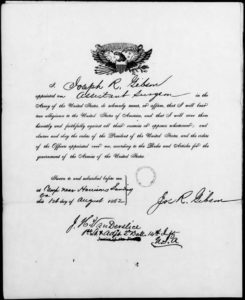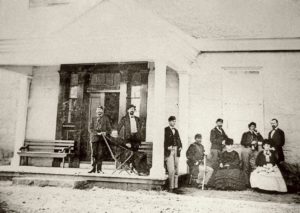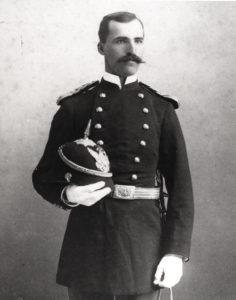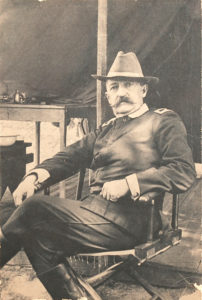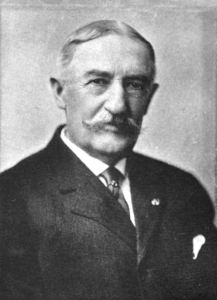Asst Surgeon Joseph R Gibson, USA (1862, c. 1870)
24 January 2023
Dr Joseph Ruff Gibson, recent graduate of the University of Pennsylvania medical school, was commissioned Assistant Surgeon, US Army on 16 April 1862, but it took a while for the formal paperwork to catch up with him. Here’s the official oath of office he returned to the Army Adjutant General in August 1862 from Harrison’s Landing, VA:
He saw his first action with the 4th United States Infantry at Antietam on 17 September 1862.
He continued in the Regular Army after the war and in 1870 was post surgeon at Fort Stanton in the New Mexico Territory. Here he is, at left, with others of the post in front of the Surgeon’s Quarters.
Left to right:
Dr. Joseph R. Gibson (Post Surgeon); Lieut. Orsemus B. Boyd (Co B, 8th Cav); Emil Fritz (Post Trader); Lieut. Casper H. Conrad (Co I, 15th Inf); Capt William McCleave (Co B, 8th Cav); Capt Chambers McKibbin (Co I, 15th Inf); Mrs. McKibbin; Lieut Richard A. Williams (Co B, 8th Cav and Post Adjutant); Mrs. Boyd; and Lawrence G. Murphy (Post Trader).
The trading post was reported to be the social center of the community, run by “Colonel Emil Fritz, veteran of the war, and Judge Lawrence G. Murphy, an ambitious merchant.”
Notes
Gibson’s written oath of office is from his papers among Letters Received by the Adjutant General, 1861-1870, in the National Archives, online from fold3. His signature was witnessed by Lt. J.H. Van Derslice, Adjutant, 14th US Infantry – who was also at Antietam in September.
The 1870 photograph is from one used on a bronze historical marker at Fort Stanton, captured for the HMDB by William F Haenn, who also provided the identification of the subjects.
That quote and much more about life at Fort Stanton may be found in Andrew Wallace’s Duty in the District of New Mexico: A Military Memoir [pdf], in the July 1975 New Mexico Historical Review.
Col Thomas M Anderson and family (c. 1897)
24 January 2023
Captain Thomas McArthur Anderson commanded a battalion of the 12th United States Infantry in action between the middle bridge over the Antietam and the town of Sharpsburg on 17 September 1862. Many years later, after a long and arduous Army career, he was Colonel of the 14th US Infantry and commanded Fort Vancouver, Washington (1886 to 1898).
Here he is with his family on “Officer’s Row” there in late 1897 or early 1898, before he was appointed Brigadier General and deployed to the Philippines on Spanish-American War service.
(back, left to right)
Thomas McArthur Anderson (1836 – 1917)
Elizabeth Van Winkle Anderson (1850-1914)
Charles Van Winkle (1821-1907)
(children, by age; I can’t tell the daughters apart)
Arline Anderson (later Cairns, 1871-1932)
Mary Anderson Allen (1874-1904)
Thomas McArthur Anderson, Jr. (1875-1936)
Elizabeth Anderson (later Gauld, 1875?-1944)
Van Winkle Anderson (1877-1960)
Irmengarde Anderson (later Patten, 1879-1945)
dog, name not known
Notes
This lovely picture accompanies a piece from the US Park Service called The Waking of a Military Town: Vancouver, Washington and the Vancouver National Historic Reserve, 1898-1920 [online in PDF]. The original photograph is in the University of Washington Libraries, Special Collections (UW475).
There’s another family portrait of the same period – and much more about the Andersons – in the 1973 monograph Thomas Anderson: First U.S. General Overseas for the Fort Vancouver Historical Society by General Anderson’s grandson Dr. Charles Anderson Gauld (1911-1977) [online PDF].
Thomas McArthur Anderson, Jr. had 4 years enlisted service in the 4th US Cavalry in Texas before being commissioned 2nd Lieutenant, 8th US Infantry on 8 June 1897, the uniform in which he is seen in the family photograph here. He served through WWI and retired as a Colonel.
Jacob Ford Kent (c. 1863, 1885, 1891, 1898, c. 1918)
23 January 2023
United States Military Academy graduate J. (Jacob) Ford Kent (May 1861) had a very long, impressive military career and maintained an impressive mustache for even longer.
He was first in combat at Bull Run in July 1861 and was wounded and captured there, but was exchanged in time to rejoin his regiment, the 3rd United States Infantry, on the 1862 Maryland Campaign. He was a staff officer for most of the rest of the Civil War and in nearly continuous action to the end.
He was afterward an instructor at the Academy and served at posts in the West and South over a span of nearly 30 years right up to the Spanish-American War.
Here he is, mid-career, as a Captain in dress uniform in about 1885.
In January 1891 he was serving again as an Inspector General, by then a Major, and his boss General Nelson A Miles detailed him with another officer, Captain Frank D. Baldwin, to investigate the recent fight of the 7th US Cavalry at Wounded Knee in South Dakota.
His facial hair makes him easy to pick out in this photograph of General Miles and staff taken that month at the scene of what has since become known as the Massacre at Wounded Knee (touch to enlarge).
On 1 July 1898, by then a Brigadier General of Volunteers, he led a Division in the famous and successful charge up San Juan Hill near Santiago, Cuba in the war with Spain. Still sporting a serious mustache.
He retired as a Brigadier General, US Army in October 1898 and still looked to be in fighting shape to near the end of his life in 1918. Here he is in a late-life photograph published by the USMA Association of Graduates in 1919:
_________________
Notes
The photograph at the top is a CDV of Kent, probably taken while he was serving as Lieutenant Colonel and Inspector General of Volunteers with the Sixth Army Corps, from 1863 to 1865; it was sold by The Horse Soldier of Gettysburg.
The 1885 photograph is from the National Park Service, Lake Roosevelt National Recreation Area, Washington, and was probably taken while Captain Kent was at Fort Spokane. It’s online in the NPGallery.
The 1891 group photograph of General Miles and staff was shared online by Sam Russell in a piece called Wounded Knee Investigation on his Army at Wounded Knee blog; an excellent source for much more detail about the Wounded Knee investigation and outcomes. Here’s Mr Russell’s caption for the photograph:
George E. Trager’s “Gen Miles and Staff during Late Indian War at Pine Ridge Agcy,” January 13, 1891. From left to right are Captain Ezra P. Ewers, Lieutenant John S. Mallory, Captain Francis E. Pierce, Lieutenant Colonel Dallas Bache, Captain Francis J. Ives, Major Jacob Ford Kent, Lieutenant Colonel Henry C. Corbin, Major General Nelson A. Miles, Captain Frank D. Baldwin, Lieutenant Sydney A. Cloman, Captain Charles F. Humphrey, and Captain Marion P. Maus. General Miles was the commanding general of the Division of the Missouri.
General Kent’s 1898 photograph was sold at auction by One Of A Kind Collectibles, Coral Gables, FL in 2012.
The last photograph is from the Fiftieth Annual Report of the Association of Graduates of the United States Military Academy, June 10, 1919.
